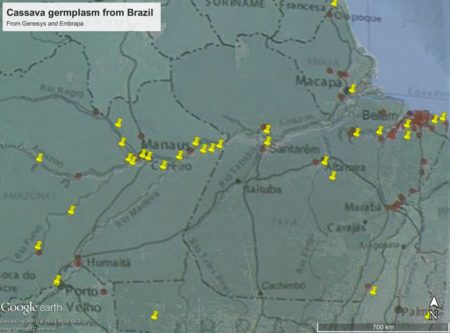You might remember a post from a couple of weeks back comparing the localities of cassava accessions in Genesys (mostly conserved at CIAT) with cultivation of the crop in Brazil. I ended that little piece with the observation that when data from the national genebank system of that country finally makes its way into Genesys, which should not be long now, it will be possible to really figure out where the gaps are in the “global” collection of the crop. Well, as it happens, there was a Tweet just recently which included a photo of a map of where Embrapa’s cassava accessions come from:
Embrapa has collected germplasm from throughout the Amazon region and has characterised this using 20,000 SNPs. Main disease problem is soft rot during heavy rains in this rainforest zone. Working on identifying pathogens & finding genes linked to resistance @IITA_CGIAR @embrapa pic.twitter.com/7go8eipUhn
— James Legg (@jamesplegg) April 28, 2018
So, quick as a flash, I imported it into Google Earth as an image overlay, and after much fiddling to make it fit on top of the background provided by GE (only partially successfully), was able to compare it with the accessions in Genesys:
The two sets of accessions (red for Embrapa, yellow for CIAT) look nicely complementary at a glance. Maybe the gaps in one collection are adequately covered by the other, and vice versa (which of course then brings up the issue of safety duplication, but that’s another post). Or maybe not: this is a really crude way of looking at the data. But it does point to the importance of data sharing and the need for collaboration among genebanks, national and international.
